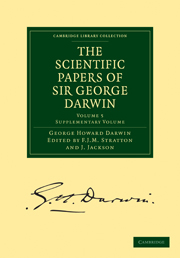Book contents
- Frontmatter
- PREFACE
- Contents
- MEMOIR OF SIR GEORGE DARWIN BY HIS BROTHER SIR FRANCIS DARWIN
- THE SCIENTIFIC WORK OF SIR GEORGE DARWIN BY PROFESSOR E. W. BROWN
- INAUGURAL LECTURE (DELIVERED AT CAMBRIDGE, IN 1883, ON ELECTION TO THE PLUMIAN PROFESSORSHIP)
- INTRODUCTION TO DYNAMICAL ASTRONOMY
- LECTURES ON HILL'S LUNAR THEORY
- ON LIBRATING PLANETS AND ON A NEW FAMILY OF PERIODIC ORBITS
- ADDRESS TO THE INTERNATIONAL CONGRESS OF MATHEMATICIANS AT CAMBRIDGE IN 1912
- INDEX
INTRODUCTION TO DYNAMICAL ASTRONOMY
Published online by Cambridge University Press: 05 June 2011
- Frontmatter
- PREFACE
- Contents
- MEMOIR OF SIR GEORGE DARWIN BY HIS BROTHER SIR FRANCIS DARWIN
- THE SCIENTIFIC WORK OF SIR GEORGE DARWIN BY PROFESSOR E. W. BROWN
- INAUGURAL LECTURE (DELIVERED AT CAMBRIDGE, IN 1883, ON ELECTION TO THE PLUMIAN PROFESSORSHIP)
- INTRODUCTION TO DYNAMICAL ASTRONOMY
- LECTURES ON HILL'S LUNAR THEORY
- ON LIBRATING PLANETS AND ON A NEW FAMILY OF PERIODIC ORBITS
- ADDRESS TO THE INTERNATIONAL CONGRESS OF MATHEMATICIANS AT CAMBRIDGE IN 1912
- INDEX
Summary
The field of dynamical astronomy is a wide one and it is obvious that it will be impossible to consider even in the most elementary manner all branches of it; for it embraces all those effects in the heavens which may be attributed to the effects of gravitation. In the most extended sense of the term it may be held to include theories of gravitation itself. Whether or not gravitation is an ultimate fact beyond which we shall never penetrate is as yet unknown, but Newton, whose insight into physical causation was almost preternatural, regarded it as certain that some further explanation was ultimately attainable. At any rate from the time of Newton down to to-day men have always been striving towards such explanation—it must be admitted without much success. The earliest theory of the kind was that of Lesage, promulgated some 170 years ago. He conceived all space to be filled with what he called ultramundane corpuscles, moving with very great velocities in all directions. They were so minute and so sparsely distributed that their mutual collisions were of extreme rarity, whilst they bombarded the grosser molecules of ordinary matter. Each molecule formed a partial shield to its neighbours, and this shielding action was held to furnish an explanation of the mutual attraction according to the law of the inverse square of the distance, and the product of the areas of the sections of the two molecules.
- Type
- Chapter
- Information
- The Scientific Papers of Sir George DarwinSupplementary Volume, pp. 9 - 15Publisher: Cambridge University PressPrint publication year: 2009First published in: 1916



